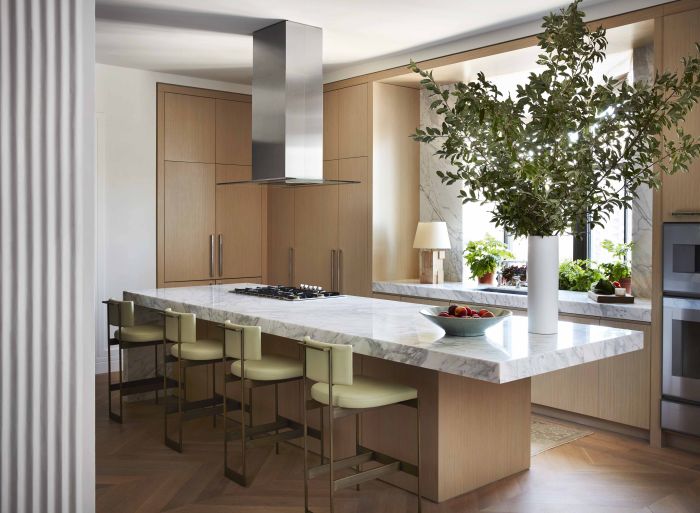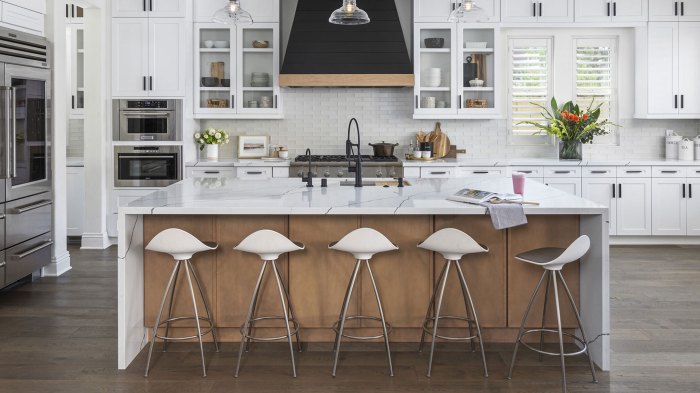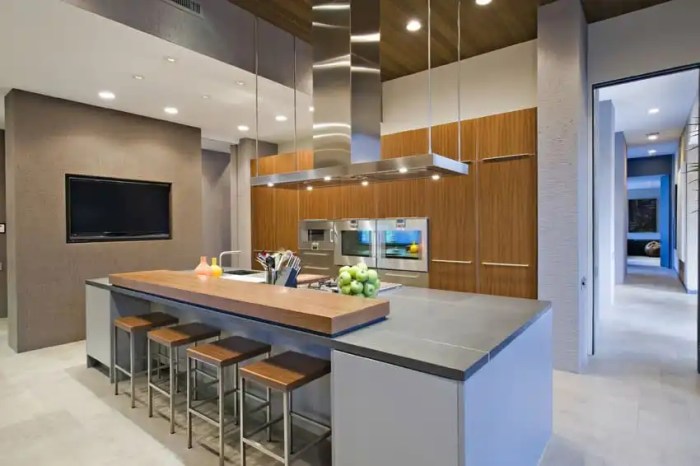Modern Kitchen Island Materials

Kitchen island decor ideas modern – Choosing the right materials for your modern kitchen island is a crucial decision impacting both aesthetics and functionality. The material you select will influence the overall look of your kitchen, its durability, and the amount of maintenance it requires over time. Consider your lifestyle, budget, and design preferences when making your selection.
Modern Kitchen Island Material Comparison
The following table compares popular materials for modern kitchen islands, highlighting their advantages and disadvantages. The cost is a broad estimate and can vary significantly based on factors like quality, sourcing, and installation.
| Material | Pros | Cons | Example Design Style |
|---|---|---|---|
| Quartz | Durable, stain-resistant, low maintenance, wide variety of colors and patterns. | Can be expensive, may chip under significant impact, less natural appearance than some other options. | Sleek, minimalist modern kitchen with a monochrome color scheme. |
| Butcher Block | Warm, natural look, durable with proper care, can be refinished, adds rustic charm. | Requires regular oiling and maintenance, susceptible to water damage if not properly sealed, can scratch easily. | Farmhouse style kitchen with exposed beams and warm wood tones. |
| Marble | Elegant, luxurious appearance, heat resistant (to a degree), unique veining patterns. | Expensive, porous and prone to staining and etching, requires regular sealing and careful maintenance. | High-end, sophisticated modern kitchen with a neutral color palette and metallic accents. |
| Concrete | Durable, unique appearance, cost-effective (relative to some others), can be customized with stains or pigments. | Can be prone to cracking if not properly installed, requires sealing, can be cold to the touch. | Industrial-style kitchen with exposed brick and metal elements. |
Durability, Maintenance, and Aesthetic Appeal of Countertop Materials, Kitchen island decor ideas modern
Durability varies significantly. Quartz is exceptionally durable and resistant to scratches and stains. Butcher block, while durable, requires regular oiling to prevent drying and cracking. Marble, though beautiful, is susceptible to etching from acidic substances and requires careful maintenance. Concrete is extremely durable but requires proper installation to prevent cracking.
Maintenance needs also differ greatly. Quartz requires minimal upkeep, while marble needs regular sealing and cleaning. Butcher block demands periodic oiling. Aesthetically, each material offers a unique appeal. Quartz offers a wide range of colors and patterns, while marble’s natural veining adds a touch of luxury.
Butcher block provides a rustic charm, and concrete brings an industrial edge.
Cost Implications of Different Materials
The initial cost of materials varies dramatically. Quartz is generally more expensive than butcher block, while marble is often the priciest option. Concrete can be a relatively affordable alternative. Long-term maintenance costs also vary. Quartz requires minimal maintenance, minimizing long-term expenses.
Marble’s high maintenance needs translate to ongoing costs for sealing and professional cleaning. Butcher block’s need for regular oiling represents a moderate ongoing expense. For example, a quartz countertop might cost $75-$150 per square foot, while marble could reach $150-$300 or more per square foot. Butcher block might cost $50-$100 per square foot, and concrete could range from $60-$120 per square foot, depending on the finish and complexity of installation.
These are estimates and can fluctuate based on location and supplier.
Modern Kitchen Island Lighting & Decor

Creating the perfect ambiance in your modern kitchen revolves around thoughtful lighting and carefully chosen decorative elements. The right combination can transform your island from a functional workspace into a stunning focal point. Let’s explore how to achieve this.
Modern Kitchen Island Lighting Schemes
Effective lighting enhances both the functionality and aesthetic appeal of your kitchen island. Three distinct schemes can achieve different moods.
- Scheme 1: Warm and Inviting. This scheme uses a combination of warm-toned pendant lights directly above the island, providing focused task lighting for food preparation. Recessed lighting in the ceiling offers ambient light, creating a cozy atmosphere. Imagine three sleek, brushed nickel pendant lights with Edison-style bulbs hanging over a butcher block island, complemented by soft, recessed lighting that washes the entire space in a gentle glow.
This creates a welcoming, family-friendly feel, ideal for casual gatherings.
- Scheme 2: Modern and Minimalist. Here, we focus on clean lines and subtle illumination. Linear LED strip lighting integrated under the island’s countertop provides functional task lighting without visual clutter. Recessed lighting, perhaps with dimmable features, provides adjustable ambient light. Picture a sleek white quartz island with under-cabinet LED strips casting a soft, white light, while strategically placed recessed lights provide a more general illumination.
The effect is sophisticated and uncluttered, perfect for a contemporary style.
- Scheme 3: Dramatic and Statement-Making. This scheme utilizes a single, large statement pendant light as the island’s centerpiece. This dramatic fixture can be a sculptural piece itself, adding visual interest. Recessed lighting provides supplemental illumination. Consider a large, globe-shaped pendant light made of smoked glass, hanging low over a dark-colored island. This single, bold light fixture makes a dramatic statement, drawing the eye and creating a sophisticated atmosphere, ideal for more formal entertaining.
Modern Decorative Elements for Kitchen Islands
The right decorative accents elevate the island’s design, adding personality and visual interest.
Modern kitchen island decor often emphasizes clean lines and minimalist aesthetics. However, the festive season calls for a touch of warmth, and incorporating seasonal elements can enhance your island’s style. For countertop inspiration, check out these creative ideas for christmas decor for kitchen counters , which can easily translate to your island. Think miniature trees, festive bowls, or even a charming garland to complement your existing modern design.
A few carefully chosen elements can make a significant difference. These additions should complement, not compete with, the overall style of the kitchen.
- Statement Planters: Large, sculptural planters with lush greenery bring life and vibrancy to the space. A single, large fern or a collection of smaller succulents in minimalist ceramic pots can add a touch of nature and soften the hard lines of the island.
- Modern Artwork: A piece of abstract art or a framed photograph can add a personalized touch and visual interest. Consider a bold, colorful print or a minimalist black and white photograph to complement the kitchen’s color palette.
- Decorative Bowls: A collection of interesting bowls – perhaps in different textures and materials – can be used to store fruit, utensils, or simply serve as decorative objects. Consider a set of rustic wooden bowls, sleek ceramic bowls, or even metallic bowls for a touch of glamour.
- Stylish Bar Stools: The bar stools surrounding the island are a key decorative element. Choose stools that complement the island’s style and overall kitchen design. Consider sleek metal stools, comfortable upholstered stools, or even stools made from natural materials like wood.
- Textured Trays: A decorative tray can serve as a beautiful centerpiece, holding items like cookbooks, candles, or small plants. Choose a tray with an interesting texture, such as woven rattan or hammered metal, to add visual interest.
Color Palettes and Textures for Modern Kitchen Islands
Color and texture play a crucial role in creating a visually appealing modern kitchen island.
The careful selection of colors and textures can dramatically impact the overall aesthetic.
Neutral color palettes, such as whites, grays, and beiges, create a clean and timeless look. These can be accented with pops of color through accessories, artwork, or bar stools. For a warmer feel, incorporate natural wood tones, while metallic accents like brushed nickel or copper can add a touch of sophistication. Consider incorporating various textures such as smooth marble, rough-hewn wood, or sleek stainless steel to add depth and visual interest.
The interplay of these elements can create a stunning and cohesive design.
Modern Kitchen Island Functionality & Appliances: Kitchen Island Decor Ideas Modern

A modern kitchen island is more than just a beautiful centerpiece; it’s a hub of activity, enhancing both functionality and style. Integrating appliances seamlessly into the island design can significantly improve workflow and create a more efficient kitchen space. However, careful consideration of both advantages and disadvantages is crucial before making such a decision.The strategic placement of appliances within the island can streamline cooking and meal preparation.
This section explores the common appliances found in modern kitchen islands, their benefits and drawbacks, and how to optimize island functionality based on its dimensions and layout.
Appliance Integration in Modern Kitchen Islands
The following table summarizes common appliances integrated into modern kitchen islands, highlighting their benefits, drawbacks, and important design considerations.
| Appliance | Advantages | Disadvantages | Design Considerations |
|---|---|---|---|
| Cooktop | Convenient central cooking location, improved workflow, creates a focal point in the kitchen. | Can generate heat, requires proper ventilation, potential for spills and burns. | Choose a cooktop material resistant to heat and stains (e.g., stainless steel, ceramic glass). Ensure adequate ventilation above the cooktop. |
| Sink | Centralized water access for cleaning and food preparation, improved workflow. | Can limit storage space beneath the island, requires plumbing considerations. | Choose a durable, easy-to-clean sink material (e.g., stainless steel, composite granite). Ensure proper garbage disposal and plumbing connections. |
| Wine Cooler | Convenient access to chilled wine, adds a touch of luxury and sophistication. | Can be expensive, requires electricity, adds to the overall island’s footprint. | Choose a wine cooler that fits seamlessly into the island’s design. Consider the number of bottles you want to store. |
| Microwave Drawer | Space-saving design, convenient access at counter height. | Can be more expensive than a traditional microwave, limited capacity compared to some over-the-range models. | Ensure the drawer is easily accessible and integrates well with the island’s cabinetry. |
Pros and Cons of Appliance Integration
Incorporating appliances into a kitchen island offers several advantages. It creates a more efficient workflow by centralizing key appliances, minimizing steps during food preparation. It also enhances the aesthetic appeal of the kitchen, often creating a striking and modern focal point. However, appliance integration can also present challenges. Plumbing and electrical work might be required, potentially increasing installation costs.
Furthermore, the integrated appliances may reduce storage space beneath the island. Careful planning and professional installation are essential to avoid unexpected problems.
Maximizing Kitchen Island Functionality
The functionality of a kitchen island is directly related to its size and layout. A larger island offers more flexibility for appliance integration and ample workspace. For example, a large island could comfortably accommodate a cooktop, sink, and a substantial amount of counter space. Conversely, a smaller island may necessitate more careful planning to maximize its functionality. In such cases, prioritizing essential appliances and optimizing storage solutions is key.
Consider using pull-out drawers, vertical storage, and other space-saving techniques to make the most of the available space. The layout of the kitchen itself also plays a significant role. Positioning the island strategically to facilitate a smooth workflow between different kitchen zones is crucial for optimal functionality. For instance, placing the island between the refrigerator and the dining area allows for seamless food preparation and serving.
Essential Questionnaire
What is the average cost of a custom kitchen island?
The cost varies significantly based on materials, size, complexity, and labor. Expect a range from several thousand to tens of thousands of dollars.
How much counter space should I allocate for a kitchen island?
The ideal amount depends on kitchen size and usage. Plan for at least 36 inches of continuous counter space for comfortable food preparation.
What are some eco-friendly materials for a modern kitchen island?
Sustainable options include reclaimed wood, bamboo, recycled glass countertops, and sustainably sourced stone.
How do I choose the right lighting for my kitchen island?
Consider the island’s size and the overall kitchen lighting. Pendant lights are common, but under-cabinet lighting and recessed lighting can also be incorporated.
